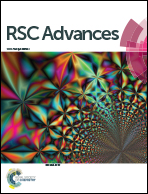Oxidative esterification of furfural over Au–Pd/HAP-T and Au–Ag/HAP-T bimetallic catalysts supported on mesoporous hydroxyapatite nanorods†
Abstract
The conversion of furfural, a lignocellulose biomass, into fuels and value-added fine chemicals has attracted many researchers. In this study, structurally uniform and porous hydroxyapatite nanorods (HAP-T) with the gel composition 1Ca2+ : 0.66PO43− : 0.3 CTAB : 120H2O were synthesized using a hydrothermal method. The synthesized HAP-T was impregnated with Au, Pd or Ag so as to obtain either monometallic (Au/HAP-T, Pd/HAP-T and Ag/HAP-T) or bimetallic (Au1−xPdx/HAP-T and Au1−xAgx/HAP-T) catalysts. The obtained hydroxyapatite catalysts were thoroughly characterized by using various analytical techniques such as FT-IR, XRD, BET, UV-DRS, XPS, HR-SEM & HR-TEM. A thorough characterization of the catalysts led to the valid information that bimetallic Au1−xPdx/HAP-T catalysts have a core–shell bimetallic morphology, whereas the Au1−xAgx/HAP-T catalysts have an alloy morphology. The catalytic activities of the bare HAP-T, monometallic (Au/HAP-T, Pd/HAP-T and Ag/HAP-T) and bimetallic (Au1−xPdx/HAP-T and Au1−xAgx/HAP-T) catalysts were evaluated at atmospheric pressure towards the oxidative esterification of furfural to methyl 2-furoate using TBHP as oxidant and methanol as solvent. Among the various synthesized catalysts, the Au0.8Pd0.2/HAP-T catalyst with a core–shell structure showed the maximum conversion of furfural (94.2%) with very high selectivity towards methyl-2-furoate (99%). In addition, the efficiency of the Au0.8Pd0.2/HAP-T catalyst was maintained even after 5 cycles, supporting its reusability and stability.


 Please wait while we load your content...
Please wait while we load your content...